The never-ending stream of social products: a flash in the pan or the next mass adoption?
By Fred, Ryze Labs
This article is 12,000 words long and will take approximately 10-15 minutes to read.
I. Introduction: What is Web3 social?
II. Why do we need Web3 social?
III. Analysis of Web3 social industry products
IV. Why is Web3 social relatively quiet compared to other tracks?
V. Business models of social
VI. Exploring the future of social: the collision of Web3 social and the AI wave
VII. Conclusion
I. Introduction: What is Web3 social?
The recent popularity of friend.tech in the past few months has once again drawn attention to Web3 social, attracting many people's attention and FOMO by giving KOL's influence a price. Later, the emergence of Bodhi also attracted a lot of attention by returning the value of data through pricing content. In the field of social networks, Web3 social seems to be undergoing some new changes and explorations. With the development of blockchain technology, it is redefining our perception of social and providing a series of innovative solutions. Whether it is SocialFi or Desoc, Web3 social is actively exploring the possibilities of future social networks.
Looking back at the development of social products, Web2 social products such as Facebook, X (formerly Twitter), Instagram, WeChat, and others have provided unprecedented convenience for users to share, interact, and communicate. However, behind this convenience lies some difficulties. Web2 social platforms usually centralize control of user data, lack transparency and privacy protection, and platform governance and decision-making are often controlled by a few centralized entities. In addition, creator incentives are also a controversial point for Web2 social products.
At the same time, Web3 social is redefining social networks in a completely new way. Web3 social emphasizes decentralization, user data privacy and control, and the incentive mechanism of cryptocurrency economics. Protocols and products such as Lens, CyberConnect, Farcaster, Phaver, Debox, friend.tech, and concepts like SocialFi are integrating finance and social, reshaping the face of social networks. Desoc, on the other hand, focuses on building a decentralized social ecosystem to eliminate many problems existing in Web2 social networks.
Although the social track has long been hoped to be the next Mass Adoption, it has not produced large-scale applications from its birth to the present. What will be the future of Web3 social? Are the never-ending social products just a flash in the pan or the next mass adoption? This research report will delve into the core concepts and solutions of Web3 social, analyze its current development, advantages, and challenges. We will return to the essence of social, examine the field of Web3 social, reveal its strengths and challenges, and discuss the role they play in redefining social networks.
II. Why do we need Web3 social?
1. The essence of social does not change with the development of history
As mentioned in Tom Standage's "A Brief History of Social Media," we often think of social media as a new concept that emerged with the development of the internet and digital technology. However, in fact, humans have always engaged in social interaction and information dissemination in different forms. From ancient letters and coffee houses to modern social networks, the essence of social media has not changed, only its form and technological tools have evolved. Social media is an extension of a human characteristic, a way for us to constantly seek connection and communication.
Observing from different historical stages, technology has had a significant impact on the development and evolution of social media, serving as an important driver of change.
Ancient and traditional media period: In ancient times, letters and postal services were the main means of social media. With the invention of printing, books and newspapers became the main tools for information dissemination, but the social scope was limited by geography and communication speed.
Telegraph and telephone era: In the late 19th to early 20th century, the appearance of the telegraph shortened the time for information dissemination, and the popularity of the telephone changed the way of long-distance communication, allowing people to communicate information more quickly.
Broadcast and television era: The broadcast and television media of the 20th century changed the way of mass communication, enabling information to be more widely disseminated, shaping cultural, political, and social ideas.
Internet and Web1.0 era: From the 1990s to the early 2000s, the emergence of the internet made information dissemination more widespread and immediate. The Web1.0 era mainly consisted of static web pages, with content primarily being a one-way transmission from official sources to users, and users were unable to actively participate in content creation, resulting in lower social interaction.
Web2.0 and the rise of social media: Since the mid-2000s, with the rise of Web2.0, more interactive and user-engaging social media platforms such as Facebook, X, and YouTube emerged. These platforms provided more user-generated content and social functions, becoming the main tools for people's daily communication, sharing, and interaction.
Web3.0 and decentralized social: Recently, with the development of blockchain and cryptocurrency technology, there has been a focus on Web3.0 social platforms that emphasize decentralization, privacy protection, and user control. These platforms attempt to address the problems of Web2.0 social, such as data privacy, algorithm filtering, and information authenticity, and provide a more secure and transparent social experience.
It is easy to see that humans have had a need for social interaction since ancient times. However, at its core, whether it is face-to-face social interaction, carrier pigeon messaging, or carving messages on stone tablets for others, the essence of human social needs has not changed much with the development of the times, and the core needs can be summarized as follows:
Maintaining connection and belonging: Social interaction makes people feel a sense of belonging, satisfying emotional and psychological needs, establishing intimate relationships, and gaining support.
Information learning and exchange: Through social interaction, people can share experiences, knowledge, and information, promoting learning, development, and personal growth.
Cooperation and mutual assistance: Social interaction helps people collaborate, cooperate, solve problems together, and achieve common goals.
Social identity and self-expression: Social interaction is a way for people to showcase themselves, establish identity, and gain recognition.

2. Web2 social meets the needs of "fast, good, and cost-effective"
After the mid-2000s, Web2 social media began to flourish. Facebook became a pioneer, providing users with functions to share information, photos, videos, status updates, and enabling users to build social networks. Subsequently, various social platforms such as X, YouTube, LinkedIn, and others emerged.
Each platform has different features and functions. For example, X, with its unique instant message dissemination and social interaction, became an important platform for information dissemination and discussion. Its 140-character limit rapidly disseminated information, becoming a hotbed for news and topic discussions; YouTube, as a video sharing platform, changed the way people watch and share videos, becoming a popular platform for content creation and sharing; LinkedIn focused on professional social networking, providing a professional network for users to build professional relationships, share work experience, and expand their network; Instagram, with its powerful image sharing function and social interaction, attracted a large number of users, becoming one of the main platforms for photo and video sharing.
During the Web2 stage, emphasis was placed on user participation, interaction, and content generation. Websites transitioned from static information display to more dynamic and interactive social platforms, allowing users to create and share content, from simple text and images to more diverse videos, blogs, and personal profiles. With the development of mobile internet and the popularity of smartphones, people could access social media platforms anytime and anywhere, driving the convenience and frequency of social activities.
And with the increase in user scale, social media has gradually become the main platform for commercial activities and advertising promotion. Companies and brands use social media to attract users and promote products, and the market value of social projects has also been soaring. The leading company Meta (formerly Facebook) has seen its market value soar since its IPO in 2012, breaking through the $1 trillion mark in 2021.
Looking back at the development history of Web2 social, the essence of social needs has not changed, but what has changed is the provision of faster, more convenient, and more cost-effective services. Facebook allows people to make friends and share information more quickly, X allows people to see hot news and engage in discussions more quickly (compared to newspapers and television), LinkedIn has transformed workplace social networking from offline introductions to rapid online networking… Essentially, Web2 social products address the "fast, good, and cost-effective" needs of social interaction.
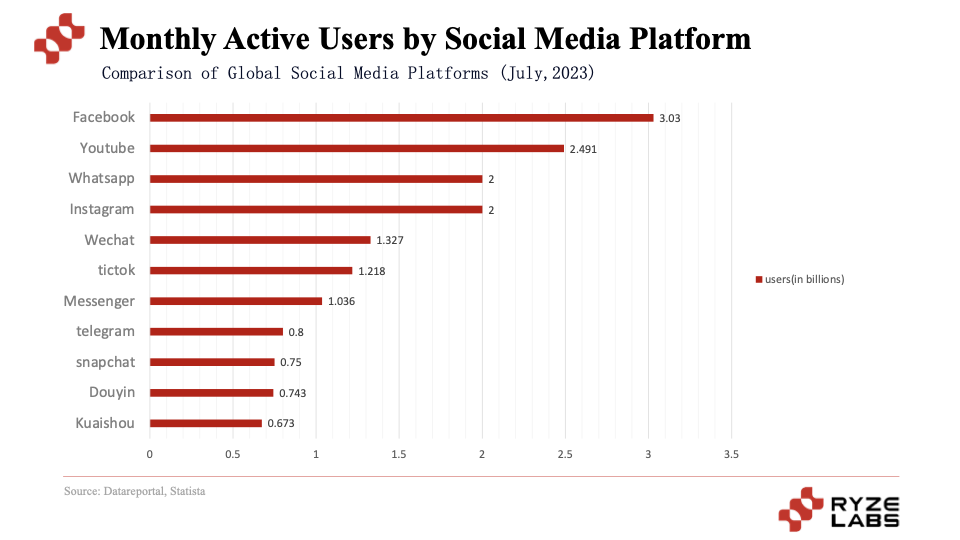
3. Challenges in the traditional social industry
However, Web2 social has also brought about some problems, which can be summarized into two core aspects: data ownership and centralization.
1) Data Ownership: In Web2 social products, user data does not belong to the users themselves, but to the platform, which leads to many problems.
- Privacy breaches: User data is extensively collected and utilized, leading to the risk of personal privacy breaches. Platforms may abuse user data or sell it to third parties, leading to privacy breaches and data misuse.
- Lack of value return to users: User data allows social platforms to conduct precise marketing and advertising, but users cannot benefit from the revenue, leading to the platform profiting from user data provision.
- Inability to cross platforms: Since user data belongs to the platform and not the users themselves, registering on different social media platforms often requires starting from scratch, and personal social information cannot be circulated across multiple platforms, making each social platform an isolated island.
In the Web2 social environment, many creators have reported that they do not receive the rightful rewards for creating most of the value, or receive only a very small portion. They can establish their own IP on social media platforms, but they do not have ownership and control over the content data and value they create. Once personal profiles are deleted from platforms like X and YouTube, all accumulated content data is lost.
2) Centralization: In Web2 social products, platforms have unlimited usage rights over content.
- Weak resistance to censorship: Since Web2 information is stored on centralized servers, freedom of speech cannot be achieved in many countries' apps due to political and cultural factors, to some extent depriving individuals of the right to free expression. Whether it's X's ever-changing rules, account suspensions, or Facebook, TikTok, and WeChat, there are too many centralized restrictions and constraints on these platforms, forcing users to dance in shackles.
Although applications like Mastodon make efforts in decentralization, there are still many unavoidable issues. While it is decentralized overall, there is still the risk of users being subject to the authoritarianism, abandonment, and prohibition of others by the specific server providers.
III. Analysis of Web3 social industry products
Faced with the various problems of Web2 social, Web3 products have begun to explore from multiple aspects, from the protocol layer to the application layer. Web3 social projects are flourishing, aiming to address different pain points in Web2 social.
Looking at the entire Web3 social industry, it can be roughly divided into four parts: the application layer, the protocol layer, the blockchain layer, and the storage layer. The social-specific chain provides customized L1 for social apps to better serve the needs of social apps, as social apps require more information exchange, higher TPS, and storage and indexing functions; the storage layer is used to store social-related data; the protocol layer provides public development components to help teams build products; and the application layer enters a specific scene based on specific needs.
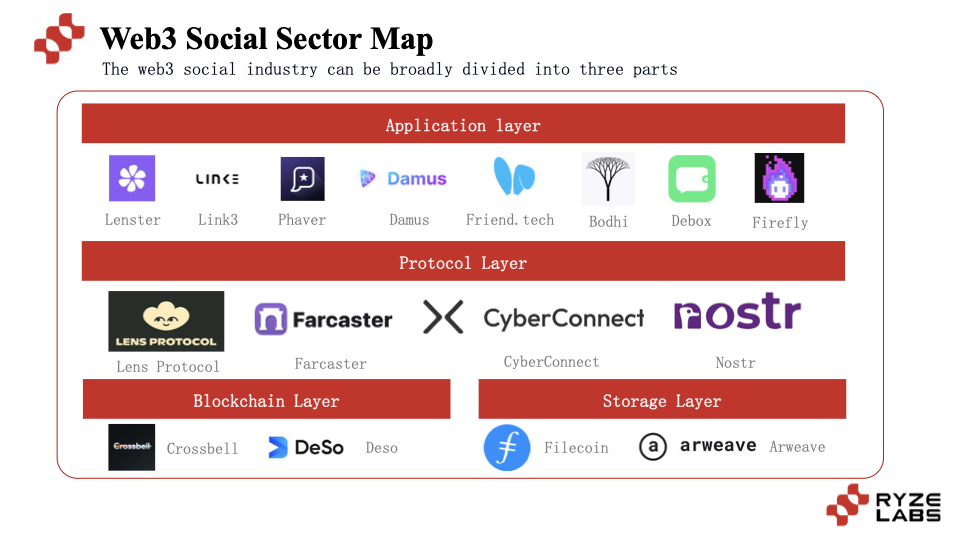
As the entire Web3 social track is still in the value verification stage, this study chooses to analyze Web3 social projects from different demand points, as comprehensively as possible.
1. Returning Data Value to Users
In traditional social products, user data is seen as platform assets rather than user property. In this situation, social platforms can use the data provided by users to implement precise ad targeting and personalized marketing. Unfortunately, the value of this data is not properly rewarded and returned to users, making it difficult for users to benefit from the value of their own data. In reality, user data contribution is seen as a form of unpaid supply, freely used by the platform, leading to data "freeloading."
In this model, whether it is the content value created by creators or the personal data provided by users, the majority of the resulting revenue is monopolized by social platforms. This centralized control results in minimal benefits for users and creators in terms of sharing data value.
However, new Web3 social products are attempting to overturn this model through token incentives, data NFTization, and other different methods.
1) Lens Protocol
Lens Protocol is a decentralized social graph protocol founded by the Aave team, a DeFi lending project, on February 8, 2022, on the Polygon chain. Its most significant feature is that all user-owned social graph data, including personal profiles, content publishing, sharing and commenting, and social relationships, will be stored in the form of NFTs.
As a representative protocol in the Web3 social track, Lens Protocol has spawned over 200 applications, with the total number of users in the ecosystem reaching 370,000. The number of monthly active users peaked at over 60,000 in March of this year, and currently maintains at 3,000 monthly active users.
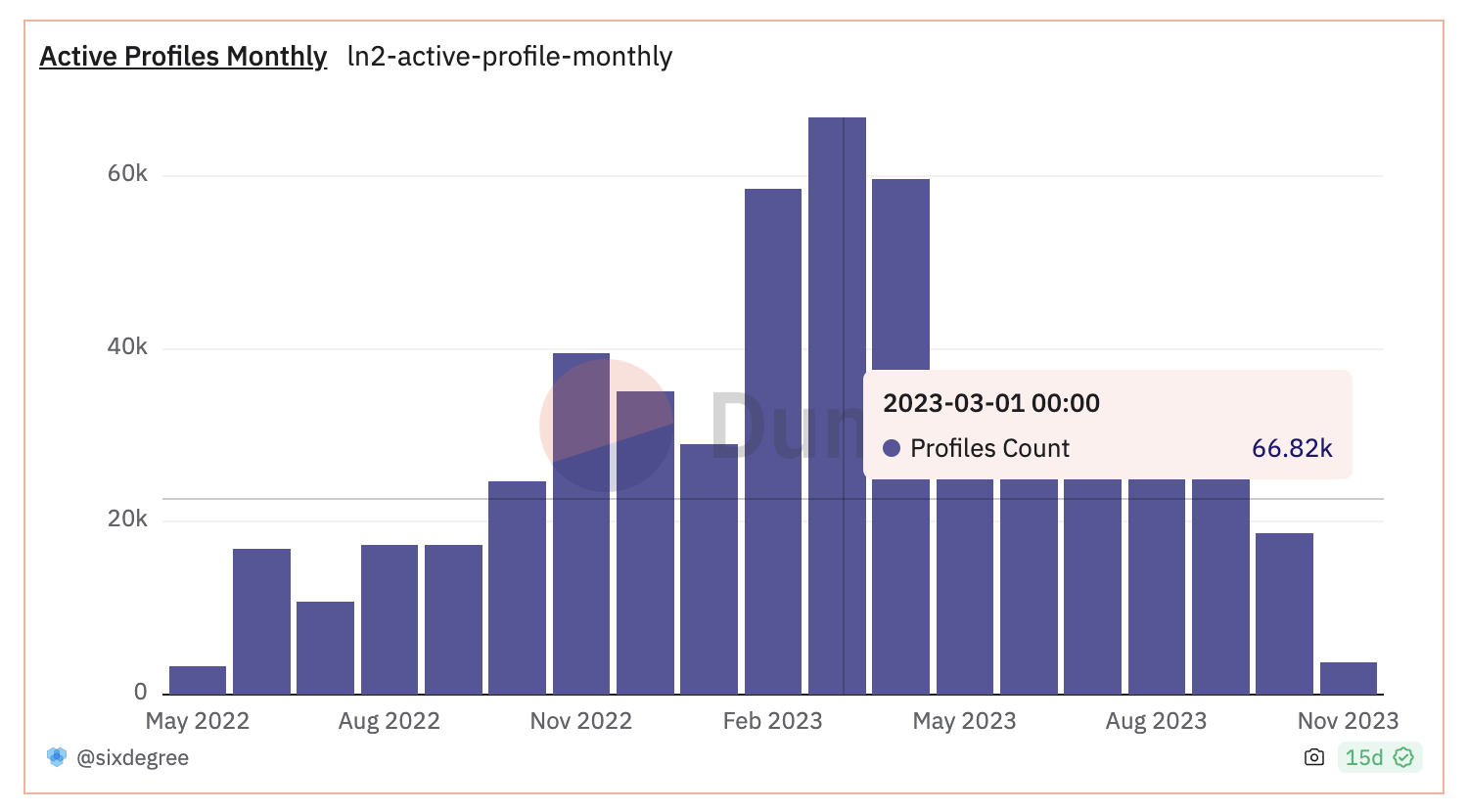
(Source: Dune)
Lens Protocol has three major features:
- Data value can be traded: In traditional social software, user-generated content and social relationships are often very valuable but do not receive reasonable incentives. For example, many KOLs on X cannot earn income from high-quality content itself, and can only make a living through advertising and product promotion. However, Lens NFTizes user data, turning all accounts into NFTs that can be freely traded on the market. However, since most people in the real world are strongly bound to their social accounts, there is little demand for trading user accounts, raising questions about the value of user account trading.
- Data circulation: Entering the protocol layer, it provides modular components for social Dapp developers to freely combine and build new social products. User profiles and all content data are controlled as NFTs. When a user logs into an application on the Lens protocol, they can synchronize all application data, achieving data circulation. For example, Lens version of Twitter and Lens version of YouTube can achieve data interoperability through a single NFT.
- High degree of decentralization: Content, social, and identity in the Lens protocol are all on-chain, making it a very crypto-native social protocol.
Based on the Lens protocol, many interesting products have emerged, such as Lenster and Phaver. Lenster is similar to X in terms of functionality and interaction experience, and can be understood as a decentralized version of X.
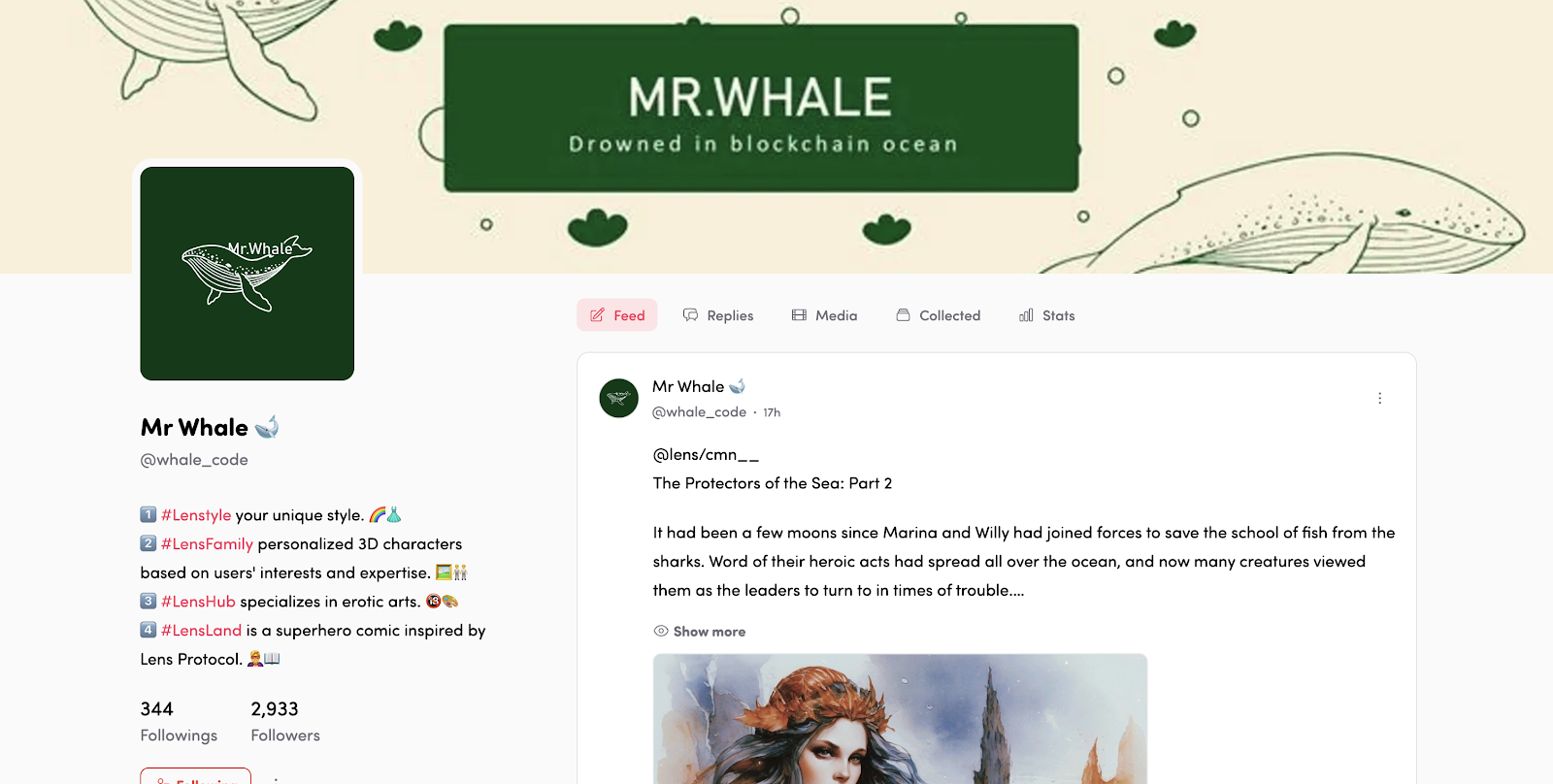
On the other hand, the model of Phaver is worth mentioning, known as "liking for rewards," using tokens to stake high-quality content. If more people stake the content, they will receive rewards, and the rewards from staking will also be distributed to the content creators. To avoid users staking only popular content, the rewards for staking popular articles will become minimal, thereby incentivizing users to be early discoverers of high-quality content, somewhat similar to venture capitalists in discovering the best targets at the earliest stage. Overall, it solves the problem of creator incentives, where the value of content depends on user recognition, and also incentivizes users to continuously seek out good content targets.
2) friend.tech
friend.tech is a socialfi project that recently gained popularity and exploded in the market. The accumulated trading volume has reached 12.48 million, with the highest daily trading volume reaching 530,000 on September 13.
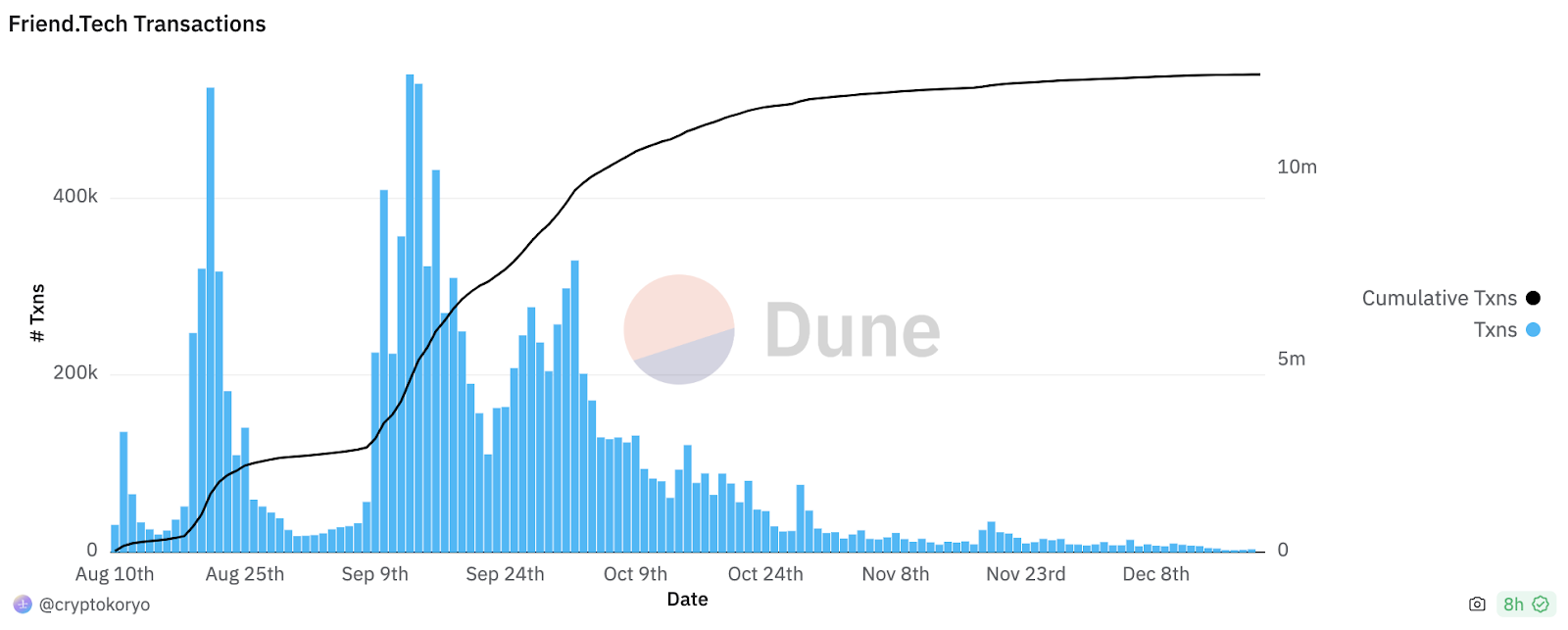
(Source: Dune)
The essence of the friend.tech project is the tokenization of personal influence to achieve fan economy:
- From the perspective of fans, on one hand, KOL's followers can purchase KOL's key on friend.tech to join KOL's private chat group and chat with the KOL they follow. On the other hand, when more people buy the KOL token, the value of the key will increase, and fans can also sell it to earn profits.
- From the perspective of KOLs, they receive a 10% commission from followers' transactions, with half of the commission going to the KOL. Therefore, after expanding their influence, KOLs also have a financial incentive, hoping that more people will buy their tokens to earn more commission fees.
In simple terms, friend.tech realizes the monetization of KOL influence value. The more reputable the KOL, the more users buy their shares, the higher their value, and the higher the purchase and selling prices.
The popularity of friend.tech in August and September also sparked discussions in both Chinese and international crypto communities. Many podcasts, videos, and communities were discussing related topics. Its popularity can be attributed to several factors:
- Innovative model: The way of using tokens to purchase KOL's key to achieve the fan economy is innovative. Although the economic model is still a Ponzi scheme, the smooth positive cycle of KOL calling for people to join, fans buying, KOL calling again, and fans buying again, can form a very smooth positive cycle. KOLs and fans have become a community of interests, jointly achieving a win-win situation.
- Capital boost: friend.tech announced a $50 million seed round financing from Paradigm on August 19, and the trading volume more than quadrupled the day after the announcement, leveraging the market heat with the endorsement of top VCs.
- PWA: friend.tech did not use a mobile app but a Progressive Web App (PWA). It provides an app-like experience through a web browser on a mobile device. Using PWA effectively avoids the need for users to download the app from the App Store or Google Play and the associated fees, making it an optional strategy for less complex applications.
In addition, common project cold start strategies such as invite code hunger marketing and user-friendly Web2 login methods have also contributed to the momentum of friend.tech.
Although friend.tech has been showing a downward trend after its peak, its innovative attempts in fan economy and value return to users have inspired many practitioners and project teams.
3) Bodhi
Bodhi is a recent and interesting Socialfi project that caused a stir in the Chinese-speaking community shortly after its release, with trading volume and participation skyrocketing. TVL surged to 165 ETH in the early hours of the second day after its release. The first article written by the author (also the project's white paper) traded at over $4,000, and it is still trading at over $2,000.
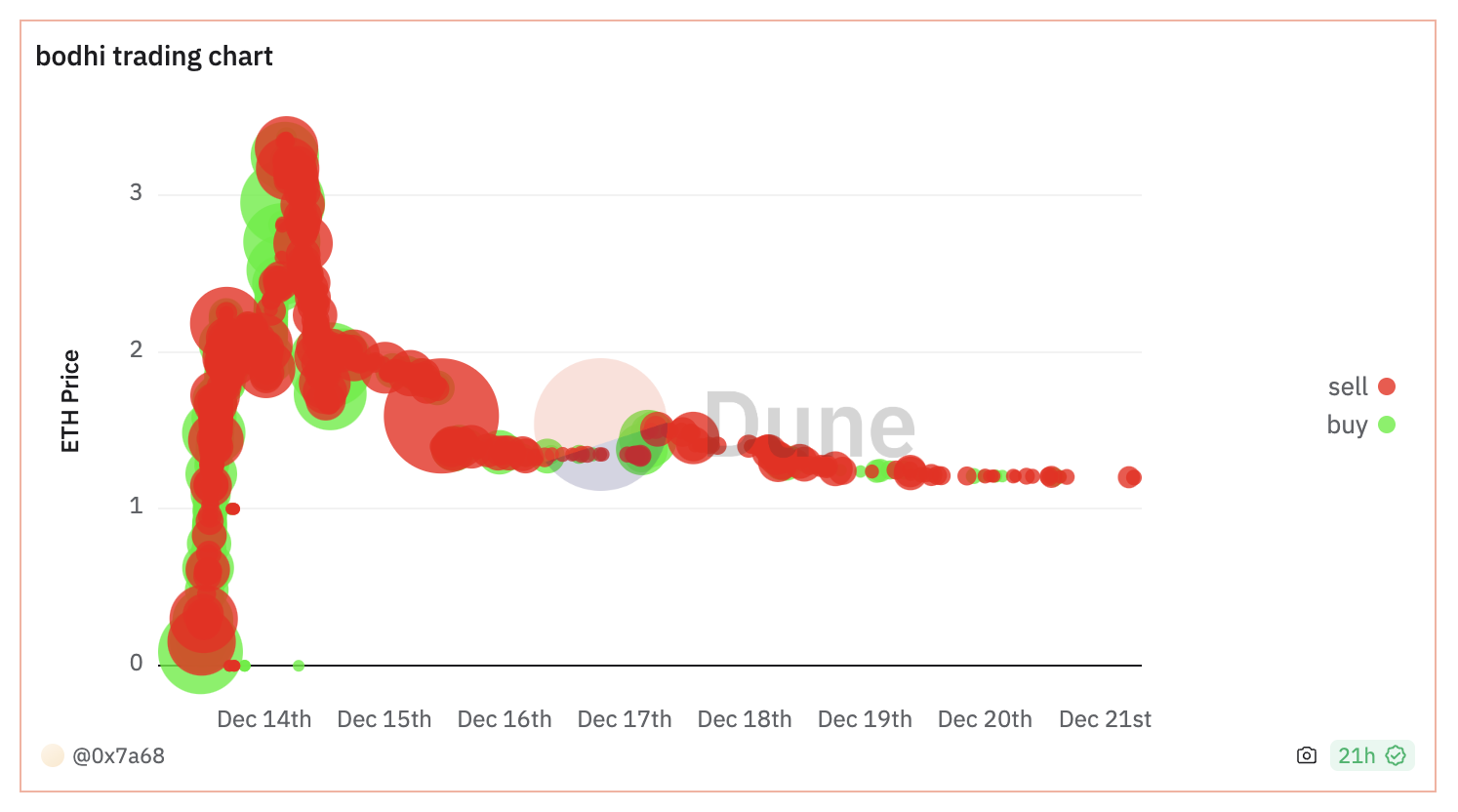
(Source: Dune)
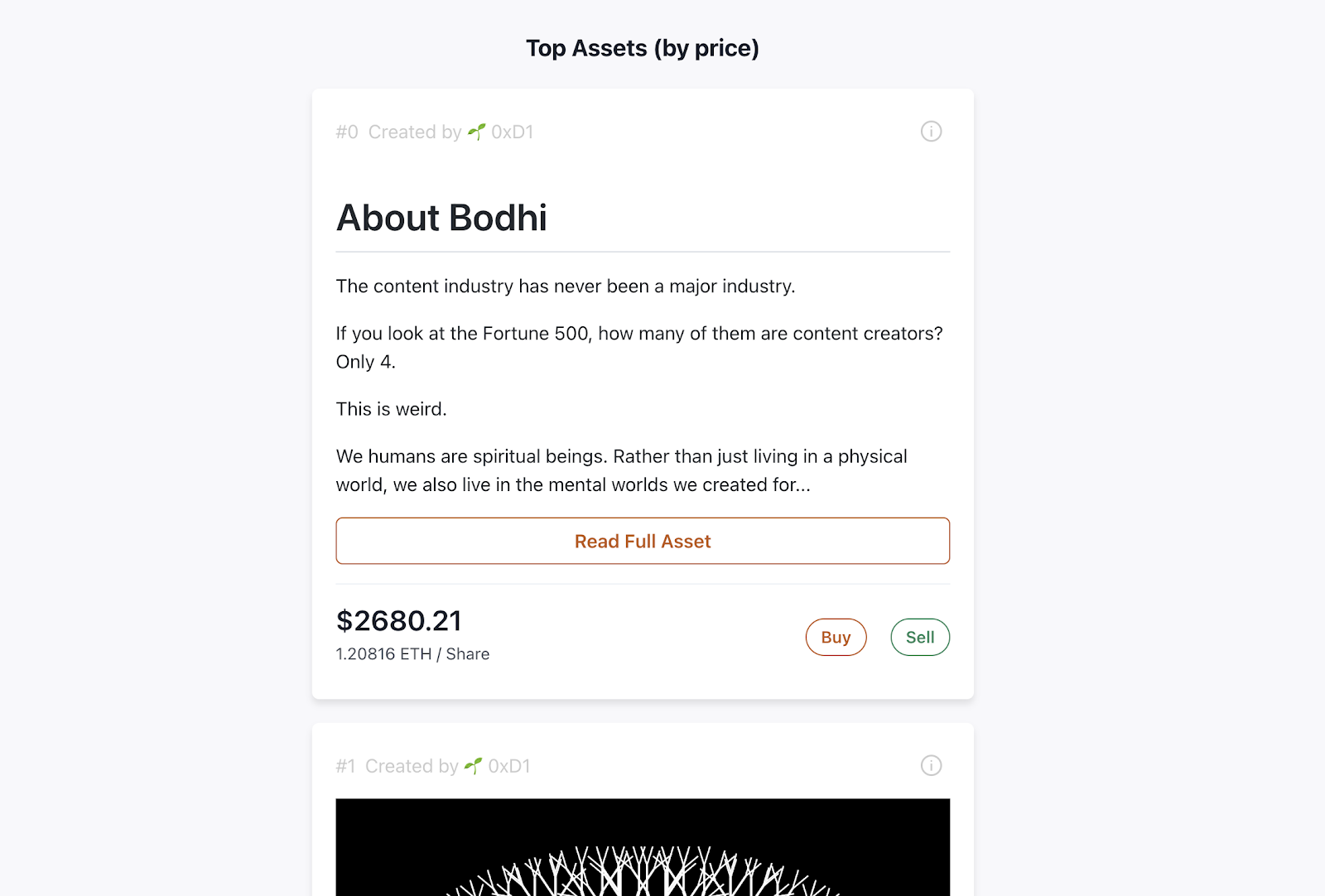
(Source: Bodhi Top Assets)
In simple terms, Bodhi's essence is the tokenization of content, similar to friend.tech's tokenization of KOL reputation. The difference is that friend.tech tokenizes the entire creator's reputation, and each purchase is a transaction for the entire creator's key. Bodhi, on the other hand, trades individual content of the creator, allowing for a larger scale of transactions and more focused trading targets. Additionally, Bodhi's content is stored on Arweave, achieving decentralized storage.
As mentioned in the Bodhi white paper, the difficulty of content incentives in Web3 is fundamentally a public goods funding issue. If content is stored on centralized servers, there is still the possibility of it disappearing at any time.
If content is stored on the chain and access is controlled through content payments, encryption and decryption are required. However, most decryption processes currently still occur on centralized servers, which is essentially no different from being hosted directly on centralized servers. And if decryption is done through blockchain mechanisms, it is fundamentally public.
A deeper exploration reveals that the two important characteristics of on-chain content also determine that it belongs to public goods: anyone can access it, and your access does not affect others' access. It is non-excludable and non-rivalrous, which is the definition of public goods. Although Bodhi did not maintain its popularity after its peak due to economic model reasons, its exploration and attempts in content incentives have brought new innovations to the social field.
4) Summary of Current Situation
Overall, in terms of returning data value to users, whether it's the protocol layer's Lens Protocol or the application-based friend.tech and Bodhi, they are all attempting to address this demand from different perspectives.
Lens Protocol uses the NFTization of user social graph data, allowing user profiles and content data to be controlled as NFTs and freely traded on the market, creating trading opportunities for high-value accounts. Additionally, Lens's modular components provide data circulation for social Dapp developers, achieving the synchronization and circulation of user data across different applications. On the other hand, friend.tech tokenizes KOL reputation, allowing fans to join private chat groups and chat with the KOL they follow, and receive influence and financial incentives. These projects enable users and creators to more fairly share the value of their data and content through value monetization mechanisms.
These new social products return the value of user data to the users themselves and achieve the liquidity and tradability of data value through certain mechanisms. Although projects like Bodhi may encounter some challenges in exploring content incentives, they provide new explorations and attempts in returning data value to users in the social field, driving social platforms towards a more fair, user-friendly, and innovative direction. In the future, with technological and community advancements, as well as the emergence of new incentive curves, Web3 social products will continue to influence social interactions, bringing more opportunities and rewards to users and creators.
In addition to data value incentives, anti-censorship is also a very important focus in current Web3 projects. Traditional Web2 social platforms are often subject to centralized management, with various restrictions on content censorship and speech. People are increasingly aware of the importance of anti-censorship. Web3 social platforms tend to be decentralized, reducing reliance on platforms, lowering the risk of censorship and bans, and advocating for more open freedom of speech. Two notable projects in this regard are Farcaster and Nostr.
1) Farcaster
Farcaster is a decentralized social protocol for developers to develop user-centric social applications. The project's founders, Dan and Varun, were former senior executives at Coinbase, and the project has received support from Vitalik. In addition to the Farcaster protocol, the official frontend product, Warpcast, has been launched, with a current daily active user base of around 2,000 and a total user base of over 40,000.

(Source: Dune)
Overall, Farcaster's two main features are:
- Decentralized identity: Farcaster stores user identity information on the chain to ensure decentralized user identity. Similar to Lens, data is tied to the user's identity, resulting in low migration costs for users across various applications within the Farcaster ecosystem.
- On-chain/off-chain integration for improved user experience: In addition to identity information, Farcaster stores high-frequency data such as user-generated content and user interaction data in the off-chain Farcaster Hub, enabling fast data transmission and a better user experience. To some extent, it sacrifices some decentralization for a better user experience.
In terms of data performance, although Farcaster has one order of magnitude fewer daily active users and total users compared to Lens, it has higher daily posting (7,000) and interaction (19,000+) numbers, demonstrating Farcaster's user stickiness. However, compared to Web2 social platforms, the user base of both Farcaster and Nostr is still in its infancy. Additionally, Farcaster's official frontend product, Warpcast, operates on a subscription-based model, requiring $1 to use. In the absence of widespread value validation, this may pose a migration cost for Web2 users accustomed to free product usage.
2) Nostr
Nostr is an open-source decentralized social protocol developed by an anonymous team, with the core goal of addressing anti-censorship. The founder, Fiatjaf, is a developer of Bitcoin and the Lightning Network.
Nostr uses a unique service framework consisting of clients and "relays." Anyone can become a relay, and relays operate independently, communicating only with users. Each user has a public key and a private key, which can be understood as their mailbox address and the key to open the mailbox. After knowing someone else's address, one can send messages, and the unique private key signature ensures the sender's identity. Similarly, the private key of the recipient, representing the "mailbox key," ensures that the recipient can receive the message.
When discussing the Nostr protocol, it is impossible not to mention the iconic project Damus, as many readers may have heard of Nostr through Damus. Earlier this year, former X CEO Jack Dorsey announced the launch of Damus on the App Store, and Damus began to sweep the globe.
Damus operates very similarly to X, with the main difference being its decentralized nature. Built on the Nostr protocol, each user of Damus is a client, forming a network of communication through countless relays. As mentioned earlier, anyone can run a relay without permission, meaning that the official censorship of user-posted information in X is difficult to occur in Damus. Users can choose any relay, including their own, to publish content, thereby maximizing anti-censorship. Although the overall gameplay is still quite rudimentary, it greatly satisfies people's desire for freedom.
Although Nostr and Damus have recently quieted down, every time Musk engages in a series of chaotic operations such as banning and censoring on X, some Web3 advocates will once again turn to the embrace of anti-censorship social platforms. The explosion of Damus also made the developers of Nostr realize that the demand for anti-censorship is always a concern for users.
While there are currently no continuously active applications on the Farcaster and Nostr protocols, if we consider Farcaster and Nostr as Layer1 in the social field, whether it's Farcaster like Ethereum or Nostr like Bitcoin, they are waiting for the next killer application.
3) Summary of Current Situation
In traditional Web2 social platforms, centralized management often leads to content censorship and speech restrictions. Platforms like X frequently ban accounts and censor content, leading to increasing attention to anti-censorship. Even before Web3, there were products like Mastodon hoping to break the restrictions of censorship. With the development of blockchain technology, more and more Web3 projects are hoping to create anti-censorship social projects and protocols similar to X and Facebook.
Whether it's Farcaster or Nostr, they are both noteworthy attempts. Although there are currently no continuously active applications on the Farcaster and Nostr protocols, Farcaster's user base is still relatively small compared to Web2 social platforms, but its high posting and interaction numbers demonstrate user stickiness. However, its subscription-based model may deter some users, especially Web2 users accustomed to free product usage, resulting in a high migration cost. After the explosion of Damus on the Nostr protocol, users did not settle down much.
However, at the time of Damus's explosion and the widespread discussion on social media, it also demonstrated people's natural curiosity and longing for a Web3 anti-censorship social product. These projects have brought new possibilities to Web3 social interactions in terms of anti-censorship exploration and attempts, providing more experience and hope for the emergence of the next killer application.
3) Native Social Scenarios Brought by Web3
In addition to data value feedback and anti-censorship, blockchain technology has brought about a series of native social needs in Web3. Projects are focusing on addressing these needs. For example, the star application in the social track, DeBox.
DeBox
The core issue addressed by DeBox is "holding chat." In traditional group chats, it is difficult to avoid the presence of other individuals, such as holders and believers of tokens or NFTs, leading to the potential presence of many scammers and malicious short sellers. DeBox's group chat function can be set to allow entry for members who hold specific NFTs or tokens and reach a certain amount, thereby establishing this consensus.
According to official data released in August this year, DeBox has over 1.1 million registered users, and the number of user logins has exceeded 13 million. It is quite popular in Web3 projects, and the recent BOX has sparked discussions.
In its early stages, DeBox used several sets of NFTs for cold start, attracting a large number of users and using holdings as a consensus to unite community members with similar views and beliefs, thereby forming a spontaneous community governance mechanism and reducing information noise. Due to its off-chain content storage and logic, the user experience is quite good, similar to the usage experience of Web2 social products.

In exploring the Web3 social field, in addition to data value feedback and anti-censorship, blockchain technology has brought about a series of native social needs. Addressing these needs has become the focus of projects. For example, as mentioned earlier, DeBox is dedicated to solving the issue of "holding chat," establishing a consensus mechanism for entry into the community for members holding specific NFTs or tokens. Thanks to its focus on community governance mechanisms, DeBox has attracted a large number of users and formed a spontaneous community. By using holdings as a consensus mechanism, it promotes the cohesion of community members with similar views and beliefs, providing a better framework for community governance and reducing information noise. ```
In addition to DeBox, there are many projects entering the social field from different angles. For example, the Cyberconnect protocol focuses on building user social graphs, and the official Link3 project aggregates users' on-chain and off-chain data, allowing users' off-chain activities to be authenticated on-chain, enriching their social image. After launching the X plugin, Mast Network also introduced the firefly aggregator, which aggregates content from projects such as Lens, Farcaster, and X, becoming a one-stop Web3 social platform.
The emergence of these projects reflects the diversity and innovation in the Web3 social field. With the native scenarios of Web3, they attempt to address different social needs, building a more diverse social environment and domain.
4. Why is Web3 social relatively quiet compared to other tracks?
As mentioned in the previous section, with the development of blockchain technology, many Web3 social projects are trying to create new solutions, focusing on data value feedback to users, anti-censorship, and addressing specific social scenarios. However, most projects are still in a relatively low-key state. Even if a few projects have gained attention for a while, they quickly quiet down. Web3 social has yet to see large-scale applications, and the challenges and limitations behind this can be summarized as follows:
1. Balancing Decentralization and User Experience
One of the biggest challenges facing current Web3 social projects is user experience.
On one hand, the user interface and operations of most Web3 social platforms are relatively complex. Compared to traditional Web2 social platforms, some Web3 social projects require wallet login, which is unfamiliar to Web2 users without wallets, hindering the entry of ordinary users into Web3 social products and limiting their development and popularity. Additionally, concepts such as blockchain and cryptocurrency are still relatively unfamiliar, requiring more education and outreach. Many people still lack understanding of the working principles and value of blockchain, which also affects the acceptance of Web3 social platforms by Web2 users. In response to this, some Web3 social products adopt Web2 account login to reduce the usage threshold.
On the other hand, there is a natural contradiction between decentralization and efficiency. If all actions and data need to be on-chain, it will lengthen the user's operational path and experience. Various social projects have taken different approaches to development, such as Lens, which puts all content, social relationships, and identities on-chain; Farcaster, which chooses to only put identities on-chain; and Debox, friend.tech, and others, which keep all data off-chain except for NFTs or tokens. They have made choices at different levels regarding user experience and partial on-chain implementation to meet specific social needs.
Full on-chain implementation brings cost and speed pressure, while partial on-chain implementation raises questions about the "Web2.5" social experience. Web3 projects are still in the stage of continuous exploration and reorganization of on-chain implementation, with a long way to go in balancing user experience and addressing actual user needs.
2. High Replacement Cost of Social Products
In our commonly used social products, such as Facebook, X, Instagram, and WeChat, there is a high replacement cost, including time, effort, learning, data migration, and rebuilding social networks. Once we have established stable social relationships on a platform, uploaded a large amount of data, and adapted to the platform's features and interface, we are more inclined to stay on that platform and are reluctant to switch to another platform.
The value of a new product often equals (new experience - old experience) - replacement cost. Due to the high replacement cost of social products, which are high-frequency use products, it is evident that social products have extremely strong network effects. Once a certain number of users become dependent on existing products, the high replacement cost makes it difficult for users to switch to other products.
Therefore, if Web3 social projects simply copy Web2 projects and add a bit of decentralization, it is difficult to attract users to migrate. Especially since the general user's perception of decentralized storage is weak, but the perception of user experience and the explicit cost of direct migration are strong. Therefore, for Web3 social products to attract users or become widely used, they need to make more innovative changes in new experiences and combine different gameplay to meet differentiated needs compared to existing products.
3. Sustainability of Data Value Feedback to Users
Due to the financial nature of the Web3 industry, many Web3 social projects or socialfi projects are beginning to integrate various economic models to accumulate user influence or content. However, most of the projects that have emerged are still in the Ponzi stage, basically requiring later participants to take over from earlier participants, without achieving sustainable development. Many times, it has evolved into a purely speculative orientation.
Finding a reasonable token economic model and function curve to balance financial attributes and sustainable development is crucial for addressing data value feedback to users in social products.
4. Low Overlap of Target Users for Social and Web3 User Profiles
According to data from Messari, in Q3 2023, the financing data for social projects was around $10 million, significantly lower than the $200 million for DeFi projects and $150 million for gaming projects. In terms of the number of financing projects, there were 6 social projects, also fewer than the 67 DeFi projects and 25 gaming projects. One important reason behind this is the low overlap of target users for social and Web3 user profiles.
Many users are attracted to the crypto field by the wealth effect, so they usually have speculative and wealth-building needs and purposes. However, social products require genuine users to engage in social behavior. Unlike some other tracks that can attract users through airdrops or TVL to increase traffic, social projects need to attract and retain users with genuine social needs, rather than one-time speculative users.
Compared to the user profile for social interaction, many gaming enthusiasts also have traits such as gambling and competitiveness, so Gamefi and gaming projects are more likely to convert users attracted from various Web3 platforms into gaming users to a higher degree. Similarly, DeFi projects can easily attract users with investment and speculative needs, with a perfect match in user profiles. The recent popularity of BRC20 inscriptions is also closely related to its huge wealth effect. The difference in demand between social users and Web3 users is naturally greater than that for gaming and finance, which may be one of the reasons why the social track is relatively quiet compared to gaming and DeFi.
In summary, compared to the gaming and DeFi tracks, the target users for social interaction are further from money, gambling, and competitiveness, with a lower overlap with Web3 user profiles. How to attract target users is a long-term exploration journey for social projects.
V. Business Models for Social Interaction
Finally, let's explore the business model considerations for full-chain games.
The evolution of social product business models can be divided into several key stages:
Early Web1.0 Stage (late 1990s to early 2000s): During this stage, social products mainly existed in the form of forums, chat rooms, etc. The business model primarily relied on advertising and membership fees. Some forums earned revenue through advertising, while chat rooms charged membership fees. For example, AOL (America Online) charged membership fees for users to access its services, and Yahoo Groups generated revenue through advertising.
Web2.0 Social Product Stage (late 2000s to 2010s): With the development of internet technology, social media and networking platforms gradually emerged. The business model during this stage mainly revolved around advertising and user data collection. Social media platforms earned revenue through advertising and targeted advertising, while user data became a valuable asset used for personalized advertising and marketing. Facebook, X, and TikTok are examples of platforms following this model.
Rise of Web3 (late 2010s): The arrival of Web3 brought the application of blockchain technology and decentralized thinking. Social products began to explore new business models such as data value feedback, token economics, and NFT-based data assets. Users gained more control over their data and could earn rewards through participation in governance and data sharing. For example, Lens tokenized data assets, friend.tech and Bodhi returned data value to users through influence incentives and content incentives, and Farcaster continued to use the traditional membership subscription model.
Additionally, due to regional market differences, there are many factors to consider when Web3 social products enter the market. For example, a significant aspect of data value feedback to users involves addressing the economic issues of creators.
Currently, the main income model for creators is still primarily B2B, with some B2C involvement. Due to the low incentives for content viewing and clicks on many domestic and international platforms, most creators have to accumulate a large amount of traffic resources to earn money through advertising from the B2B side. Some creators have also started to explore B2C methods such as live streaming sales, but both income models have a certain negative impact on the creator's brand and reputation. Therefore, many Web3 social projects hope to start with a B2C model, allowing creators to directly receive fair returns from high-quality content. This is also the approach of friend.tech and Bodhi (through influence incentives and content incentives).
In the Chinese market, social and creator platform traffic is highly monopolized, with platforms like WeChat, Douyin, and Kuaishou occupying the majority. The platforms are very dominant, and creators have low bargaining power, receiving minimal revenue shares. It is difficult for creators to earn a living through platform traffic incentives, so they have to choose the B2B model to generate commercial income, including advertising and live streaming sales. However, due to the platform's dominance, it is challenging to redirect traffic to private domains. Therefore, Chinese creators tend to focus on studying platform recommendation strategies, creating content types that can generate high traffic, and then monetizing the traffic.
In the overseas market, social platform monopolization is slightly better than in China, and there is relatively higher circulation of public and private domain traffic (the concept of private domain emerged due to the dominance of public domain in China). Therefore, creators on overseas social media platforms like Instagram and YouTube can redirect traffic to their independent websites or pages after gaining followers, to sustain themselves. This allows many overseas creators to create niche content they enjoy and effectively redirect traffic to private domains.
In the face of the competitive landscape of traditional social products in different regions, Web3 social projects can consider different strategies when entering the market.
Overall, the business models of current Web3 social projects are still in a stage of diverse exploration and validation. Looking back at the history of social products, the evolution of business models has shown a trend from a single advertising revenue model and membership revenue, to precise advertising targeting after data monopolization, and then to the development trend of returning data value to users through token/NFT. The future direction may focus more on user data value, user engagement, community governance, and more diverse business models.
VI. Future Exploration of Social Interaction: Collision of Web3 Social and the AI Wave
In the recent wave of technological development, Web3 and AI are two highly anticipated fields. This is also true for the exploration of social interaction. In addition to Web3/Crypto social projects, there have been many AI projects emerging recently, including some traditional Web2 teams that have begun to integrate social interaction and AI, with applications in matching, translation, and virtual personalities.
For example, in the Chinese market, Soul has introduced an intelligent conversational AI "AI Goudan" for personalized communication with users. Similarly, Baidu has launched the AI social app "Skyclub" to re-enter the social track with the help of AI. In the overseas market, Meta has increased user activity by combining AI with social information flow recommendations. The optimization of recommendation algorithms last year increased user retention by 7% for Facebook and 6% for Instagram. The development of products in both domestic and international markets shows that the combination of social products and AI is an important development trend.
AI, as a tool for enhancing productivity, has empowered the field of social interaction. One particularly noteworthy area is the combination of social interaction and AI agents, using AI to create virtual girlfriends, boyfriends, and companions to meet human needs for companionship and emotional support. For example, Character.AI, invested in by A16Z, can generate human-like text responses and engage in contextual conversations, creating intelligent chatbots for user interaction.
As mentioned earlier, one of the core human needs for social interaction is to fulfill emotional and psychological needs, establish intimate relationships, and receive support. Currently, AI+social projects are mainly focused on meeting human emotional needs, starting with virtual companionship to address the need for companionship that real people cannot always provide in real-time, exploring new possibilities for meeting these needs. However, the question of whether human emotional companionship needs to be fulfilled by AI virtual personalities is still in the stage of market and value validation.
In the development of social products, we find that Web3 and AI have complementary potential in the field of social interaction. Unlike AI's enhancement of productivity, the characteristics of Web3 in production relations and financial incentives can also empower social products. For example, Myshell, incubated by Binance, combines AI with Web3, allowing users to create their own AI robots. It has also launched Samantha, a voice chatbot based on Telegram, to meet human emotional companionship needs. Its token, shell, is used to incentivize the entire product ecosystem, including content consumers paying for features and creators using tokens to increase traffic exposure, and more.
Additionally, Siya.AI in the Solana ecosystem aims to build a social companion platform where AI agents and real people coexist, using the Realy SDK to introduce incentives for creator economics and AI companions. By combining AI and Web3, the project aims to address the emotional companionship needs in social interaction. Users can chat with AI boyfriends and girlfriends and even engage in chat mining and NFT incubation.
In summary, AI and Web3, as two waves of the new era, are making efforts in the field of social interaction from different perspectives. The former focuses on emotional companionship and support, while the latter focuses on data value feedback to users and anti-censorship. Both are still in the early stages. Regardless of which need point they address, they both aim to better meet the original human needs for social interaction. In the exploration of social products, the collaboration and complementarity of AI and Web3 have emerged. It is highly anticipated that under the birth of new technologies and models, the collision of AI and Web3 in the field of social interaction will spark new innovations to better meet the diverse needs of human social interaction.
VII. Conclusion
Social interaction is a basic need for everyone, regardless of age, gender, or familiarity with others. Social products have been the gateway to traffic in the Web2 industry and have the highest Daily Active Users (DAU). Therefore, since the concept of Web3 social emerged, it has been highly anticipated by Web3 practitioners for mass adoption.
On the positive side, Web3 social has brought revolutionary changes in data value and user feedback. Compared to traditional Web2 social products, Web3 views user data as a valuable asset and returns the value of data to users through token incentives, NFTs, and other methods, based on user data sharing, creator incentives, and community consensus.
Furthermore, the anti-censorship nature of Web3 social products provides users with greater freedom and privacy protection. Through blockchain technology and decentralization, these products reduce the risk of censorship and banning, advocating for open freedom of speech. This creates a safer, more open social environment, making social interaction more authentic and free.
However, current Web3 social products still face some challenges and have not yet achieved widespread application. High switching costs and network effects are significant challenges. Traditional social products have established strong network effects among users, making it difficult for them to migrate to new Web3 social platforms due to user habits, resource investment, and platform dependence. This makes it challenging for new Web3 products to expand their user base and grow. Another challenge is the balance between sustainability and user experience. Some Web3 social products emphasize decentralization and data control but sacrifice user experience and convenience. Balancing innovation with usability and attractiveness is crucial for user retention and engagement.
As Tom Standage mentioned in his book "A History of Social Media," humans have had a need for social interaction since the beginning of time, and regardless of technological evolution, humans have always needed to exchange information. From papyrus letters used by ancient Roman politicians to propaganda leaflets during the American Revolution and French Revolution, from newspapers, radio, and television to the internet and blockchain technology, humans have always undergone transformation in the tension between speed, quality, cost, freedom of speech, and censorship.
Compared to telephones, text messages, and newspapers, Web2 social products like Facebook, X, and WeChat have enabled people to communicate and disseminate information faster, better, and more affordably. The core focus of Web3 is on anti-censorship freedom of speech and returning data value to users. Although there has not been widespread application like Web2 products, the demand for anti-censorship and data value return still exists in the hearts of users, waiting for a moment of eruption.
For future focus points, community attributes can be considered. Social interaction is not broadcast-style but always oscillates between centralization and decentralization. Community is a very important feature of Web3 social, and its data sovereignty and openness are well-matched with the community. Communities can facilitate multi-directional, interactive social interaction and may become one of the future focus areas for Web3 social products. Additionally, the intersection with gaming and other areas may also spark different innovations.
As mentioned in the challenges and limitations of Web3 social, there is a dilemma in user profiling in the social track, making the Web3 social track somewhat quieter compared to the BRC20 track. However, the development prospects of Web3 social still hold high expectations for many people. The emergence of new projects and technologies continues to drive the advancement of this field. As technology continues to evolve, we also see more exploration and improvement focused on sustainability and user experience. This field is maturing, finding its own development path, bringing more innovation to users, and having a profound impact on the entire social domain.
Finally, I would like to express my sincere gratitude to partners such as Hei Tie, Adazz, Ashan, Harlan, Trinity, and others for their help and patience in sharing during the communication process. I truly hope that the builders in this track will continue to improve and excel!
免责声明:本文章仅代表作者个人观点,不代表本平台的立场和观点。本文章仅供信息分享,不构成对任何人的任何投资建议。用户与作者之间的任何争议,与本平台无关。如网页中刊载的文章或图片涉及侵权,请提供相关的权利证明和身份证明发送邮件到support@aicoin.com,本平台相关工作人员将会进行核查。




